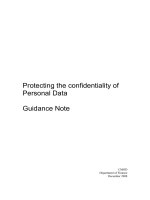Protecting the confidentiality of Personal Data Guidance Note phần 1 docx
Bạn đang xem bản rút gọn của tài liệu. Xem và tải ngay bản đầy đủ của tài liệu tại đây (210.48 KB, 12 trang )
Protecting the confidentiality of
Personal Data
Guidance Note
CMOD
Department of Finance
December 2008
2
Contents
Introduction 3
Scope 3
Audience 4
General Procedures 5
Paper Records 9
Email and Personal Productivity Software 11
Remote Access 12
Laptops and Other Mobile Storage Devices (incl. Mobile Phones, PDAs,
USB memory sticks, External Hard Drives, etc.) 14
Data Transfers 17
Appropriate Access and Audit Trail Monitoring 20
Breach Management 21
3
Introduction
Under the Data Protection Acts, 1988 and 2003, Government Departments, Offices
and Agencies, as data controllers, have a legal responsibility to:-
- obtain and process personal data fairly;
- keep it only for one or more specified and explicit lawful purposes;
- process it only in ways compatible with the purposes for which it was given
initially;
- keep personal data safe and secure;
- keep data accurate, complete and up-to-date;
- ensure that it is adequate, relevant and not excessive;
- retain it no longer than is necessary for the specified purpose or purposes; and,
- provide a copy of his/her personal data to any individual, on request.
The purpose of these guidelines is to assist Departments, Offices and Agencies in
implementing systems and procedures that will ensure, as much as possible, that
personal data in their possession is kept safe and secure and to help Departments,
Offices and Agencies meet their legal responsibilities as set out above. This
document can be expanded upon by Departments
1
to create detailed policies and
procedures which reflect their specific business requirements.
Any queries in relation to the content of this document should be forwarded via email
to
Scope
This document provides guidelines on how personal data is to be stored, handled and
protected under the following headings:-
a. General Procedures;
1
For “Departments” read “Departments, Offices and Agencies” throughout this document
4
b. Paper Records;
c. Email and Personal Productivity Software;
d. Electronic Remote Access;
e. Laptops/Notebooks;
f. Mobile Storage Devices;
g. Data Transfers;
h. Inappropriate Access/Audit Trail Monitoring;
i. Breach Management.
Audience
The information contained in this document is intended for general distribution.
However, it is especially important that senior management in Departments are aware
of the contents of the document as the responsibility rests with them to ensure that the
guidelines contained in it are followed. The guidelines should also be brought to the
attention of all staff whose work involves the handling of personal data.
5
General Procedures
This document sets out guidelines in a number of specific areas where particular
attention should be paid in order to help protect the confidentiality of personal data
held in a Department. There are, however, a number of general procedures which
Departments should follow:-
1. The first stage in establishing policies and procedures to ensure the protection of
personal data is to know what data is held, where it is held and what the
consequences would be should that data be lost or stolen. With that in mind, as
a first step Departments should conduct an audit identifying the types of
personal data held within the organisation, identifying and listing all information
repositories holding personal data and their location. Risks associated with the
storage, handling and protection of this data should be included in the
Department’s risk register. Departments can then establish whether the security
measures in place are appropriate and proportionate to the data being held while
also taking on board the guidelines available in this document;
2. Access to all data centres and server rooms used to host hardware and software
on which personal data is stored should be restricted only to those staff members
that have clearance to work there. This should, where possible, entail swipe
card and/or PIN technology to the room(s) in question – such a system should
record when, where and by whom the room was accessed. These access records
and procedures should be reviewed by management regularly;
3. Access to systems which are no longer in active use and which contain personal
data should be removed where such access is no longer necessary or cannot be
justified;
4. Passwords used to access PCs, applications, databases, etc. should be of
sufficient strength to deter password cracking or guessing attacks. A password
should include numbers, symbols, upper and lowercase letters. If possible,
password length should be around 12 to 14 characters but at the very minimum
6
8 characters. Passwords based on repetition, dictionary words, letter or number
sequences, usernames, or biographical information like names or dates must be
avoided. Departments must also ensure that passwords are changed on a regular
basis;
5. Departments should have procedures in place to properly evaluate requests from
other organisations for access to personal data in its possession. Such
procedures should assist Departments in assessing whether the release of
personal data is fully justifiable under the Data Protection Acts. Departments
should also ensure that access by staff of personal data for analysis or research
purposes is fully justifiable and proportionate;
6. Personnel who retire, transfer from the Department, resign etc. should be
removed immediately from mailing lists and access control lists. Relevant
changes should also occur when staff are transferred to other assignments
internally. It is the responsibility of Departments to ensure that procedures are
in place to support this, i.e. so that notification is provided to the relevant
individual(s)/Unit in a timely fashion;
7. Contractors, consultants and external service providers employed by
Departments should be subject to strict procedures with regard to accessing
personal data by way of formal contract in line with the provisions of the Data
Protection Acts. The terms of the contract and undertakings given should be
subject to review and audit to ensure compliance;
8. Departments should have in place an up-to-date Acceptable Usage Policy in
relation to the use of Information and Communications Technology (e.g.
telephone, mobile phone, fax, email, internet, intranet and remote access, etc.)
by its staff. This policy should be understood and signed by each user of such
technology in the Department;
9. Departments’ Audit Committees, when determining in consultation with
Secretaries General (or CEOs, etc. where relevant) the work programme of their
Internal Audit Units (IAUs), should ensure that the programme contains
7
adequate coverage by IAUs of areas within their organisations which are
responsible for the storage, handling and protection of personal data. The
particular focus of any review by IAUs would be on assessing the adequacy of
the control systems designed, in place and operated in these areas for the
purpose of minimising the risk of any breach of data protection regulations.
Risks associated with the storage, handling and protection of personal data
should be included in the Department’s risk register and risk assessments should
take place as part of a Department’s risk strategy exercise. Furthermore,
external audits of all aspects of Data Protection within the organisation may be
conducted on a periodic basis by the Office of the Data Protection
Commissioner.
10. Procedures should be put in place in relation to disposal of files (both paper and
electronic) containing personal data. In doing so, Departments should be aware
of their legal obligations as set out in the National Archives Act, 1986 and the
associated National Archives Regulations, 1988. It should be noted that
incoming and outgoing emails which are ‘of enduring interest’ are archivable
records under the Act. Procedures should also be put in place in relation to the
secure disposal of computer equipment (especially storage media) at end-of-life.
This could include the use of degaussers, erasers and physical destruction
devices, etc;
11. Quality Customer Service documentation/customer charters should detail how
customers’ data is held and how it will be used/not used. Website privacy
statements should be regularly reviewed to take account of any enhancements,
new practices or additional services which involve the collection and use of
personal data;
12. New staff should be carefully coached and trained before being allowed to
access confidential or personal files;
13. Staff should ensure that callers to the office or other unauthorised persons are
unable to view personal or sensitive information whether held on paper
documents or information displayed on PC monitors, etc.;
8
14. All staff should ensure that PCs are logged off or ‘locked’ when left unattended
for any period of time (e.g. in Windows, using Ctrl+Alt+Del keys). Where
possible, staff should be restricted from saving files to the local disk. Users
should be instructed to only save files to their allocated network drive;
15. Personal and sensitive information should be locked away when not in use or at
end of day;
16. Appropriate filing procedures (both paper and electronic) should be drawn up
and followed;
17. Departments should be careful in their use of the Personal Public Service
Number (PPSN) in systems, on forms and documentation. There is a strict
statutory basis providing for the use of the PPSN. This allows organisations use
the PPSN in support of a provision of a public service to a customer. The
Department of Social & Family Affairs manages the issuance and use of PPS
Numbers. A register of organisations that use the PPSN has been prepared and
published to promote transparency regarding the ongoing use and future
development of the PPSN as a unique identifier for public services. The register
is available at: .
18. Any databases or applications in use by Departments which contain personal
data must be registered with the Office of the Data Protection Commissioner.
9
Paper Records
The Data Protection Acts apply equally to personal data held on ICT systems and on
paper files. The following guidelines should be followed with regard to personal and
sensitive data held on paper files:-
1. Paper records and files containing personal data should be handled in such a
way as to restrict access only to those persons with business reasons to access
them;
2. This should entail the operation of a policy whereby paper files containing such
data are locked away when not required;
3. Consideration should also be given to logging access to paper files containing
such data and information items;
4. Personal and sensitive information held on paper must be kept hidden from
callers to offices;
5. Secure disposal of confidential waste should be in place and properly used. If
third parties are employed to carry out such disposal, they must contractually
agree to the Department’s data protection procedures and ensure that the
confidentiality of all personal data is protected. Such contracts should contain
clauses similar to those outlined in the section on ‘Data Transfers’ below;
6. When paper files are transferred within a Department, this usually entails hand
delivery. However, it should be noted that, in many cases, internal post in
Departments ultimately feeds into the general postal system (this is particularly
true for Departments with disparate locations). In these instances, senders must
consider registered mail or guaranteed parcel post service where appropriate.
Procedures must be in place for ensuring that the data is delivered only to the
person to whom it is addressed, or another officer clearly acting on their behalf,
10
and not any other staff member. Consideration should also be given to the
security of manual files when in transit internally;
7. Facsimile technology (fax machines) should not be used for transmitting
documents containing personal data.
11
Email and Personal Productivity Software
Email and other personal productivity software such as word processing applications,
spreadsheets, etc. are valuable business tools which are in use across every
Department. However, Departments must take extreme care in using this software
where personal and sensitive data is concerned. In particular:-
1. Standard unencrypted email should never be used to transmit any data of a
personal or sensitive nature. Departments that wish to use email to transfer such
data must ensure that personal or sensitive information is encrypted either
through file encryption or through the use of a secure email facility which will
encrypt the data (including any attachments) being sent. The strongest
encryption methods available should be used. Departments should also ensure
that such email is sent only to the intended recipient. In order to ensure
interoperability and to avoid significant key management costs, particular
attention should be paid to any central solutions put in place for this purpose;
2. Departments should consider implementing solutions that scan outgoing emails
and attachments for keywords that would indicate the presence of personal data
and, if appropriate, prevent its transmission;
3. Where personal or sensitive data is held on applications and databases with
relevant security and access controls in place, additional controls should be
considered that would prevent such data from being copied to personal
productivity software (such as word processing applications, spreadsheets, etc.)
where no security or access controls are in place and/or can be bypassed.
12
Remote Access
There is an increasing business requirement for mobile working and e-working across
the public service. Consequently, the demand from staff to access remotely the same
systems that they can access from the office is increasing. This brings its own
challenges in relation to data security which Departments must address. With regard
to personal and sensitive data, the following guidelines should be adhered to:-
1. In the first instance, all personal and sensitive data held electronically should be
stored centrally (e.g. in a data centre or in a Department’s secure server room
with documented security in place). Data that is readily available via remote
access should not be copied to client PCs or to portable storage devices, such as
laptops, memory sticks, etc. that may be stolen or lost;
2. When accessing this data remotely, it must be done via a secure encrypted link
(e.g. IPSEC or SSL VPN tunnel) with relevant access controls in place;
3. Additional stringent security and access controls should be in place, e.g. the
mandatory use of strong passwords and security token authentication (i.e. two-
factor authentication);
4. Data being accessed in this way should be prevented from being copied from the
central location to the remote machine;
5. Departments must utilise technologies that will provide for the automatic
deletion of temporary files which may be stored on remote machines by its
operating system;
6. Departments should ensure that only known machines (whether desktop PC,
laptop, mobile phone, PDA, etc.) configured appropriately to the Department’s
standards (e.g. with up-to-date anti-virus and anti-spyware software, full
encryption, etc.), are allowed to remotely access centrally held personal or
sensitive data. The strongest encryption methods available should be used to









